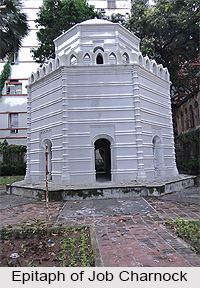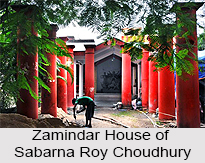 Gobindapur was one of the three villages located in Kalikata District of Greater Bengal in the Middle Ages and the early part of modern age, when British East India Company came for trade in Bengal.
Gobindapur was one of the three villages located in Kalikata District of Greater Bengal in the Middle Ages and the early part of modern age, when British East India Company came for trade in Bengal.
Foundation of Gobindapur
Gobindapur was built with the hands of Gobinda Sharan Dutta Chaudhuri, who belonged to the Zamindar family of Dutta Chaudhuri of Andul in Howrah who was returning by boat from a pilgrimage. He dreamt of goddess Kali asking him to dig the barren land on the bank. He did so and discovered enormous qualities of wealth hidden underground. He stayed back and founded Gobindapur. It was named after him. Later Job Charnock favoured Sutanuti as a settlement because of the security of the location. It was protected by the Ganga River on the west and by impassable marshes on the south and the east.
Villages with Gobindapur
Along with Gobindapur, the other two villages of early Kolkata were Kalikata and Sutanuti. Job Charnock was an administrator with the British East India Company. While Kalikata and Sutanuti lost their identity as the city grew, Gobindapur was demolished to make room for the construction of new Fort William.
Coming of Portuguese
 When the Portuguese traders started to frequent Bengal, in the year 1530, the two great centres of trade were Chittagong, which the Portuguese called Porto Grande or Great Haven, in the east and Satgaon, which the Portuguese called Porto Piqueno or Little Haven in the west. Adi Ganga was then the outlet to the sea and ocean-going ships came up to where Garden Reach is now, then the anchoring place for ships. Only country boats operated further up the river. Then Saraswati River was another watery life line. It started drying up from the middle of the sixteenth century. The Portuguese traders built a new port at Hugli in 1580.
When the Portuguese traders started to frequent Bengal, in the year 1530, the two great centres of trade were Chittagong, which the Portuguese called Porto Grande or Great Haven, in the east and Satgaon, which the Portuguese called Porto Piqueno or Little Haven in the west. Adi Ganga was then the outlet to the sea and ocean-going ships came up to where Garden Reach is now, then the anchoring place for ships. Only country boats operated further up the river. Then Saraswati River was another watery life line. It started drying up from the middle of the sixteenth century. The Portuguese traders built a new port at Hugli in 1580.
Bengal in 16th Century
Towards the end of the sixteenth century, the Indian merchant-princes of Port Piqueno were forced to seek another market for their trade. Most of them settled down in Hooghly district, but four families of Basaks and one of Sheths, determined to profit by the growing prosperity of Betor, founded the village of Gobindapur, on the east bank of the river. Gobindaji was the family deity of the Sheths and Basaks, and so they named the village Gobindapur.
 Decline of Gobindapur
Decline of Gobindapur
European buildings are lying around the Fort William, after the coming of British East India Company and after the defeating of independent Muslim rules in Bengal, the village Gobindapur was converted into modern Kolkata. These villages were the original three with the addition of Chowringhee, which was in 1717 a hamlet of isolated hovels, surrounded by water-logged paddy fields and bamboo-groves and separated from Gobindpur by a tiger-haunted jungle where expands the grassy level of the maidan. The Esplanade was a jungle not yet cleared, interspersed with a few huts and small plots of grazing and arable lands. Beyond the Chitpur Road which formed the eastern boundary of the settlement, lay more pools, swamps and rice fields, dotted here and there with the struggling huts of fishermen, falconers, wood-cutters, weavers and cultivators. The three villages were part of the Khas Mahal or imperial jagir, whose zemindari rights were held by the Sabarna Roy Choudhury family of Barisha, now in Behala. On 10th November 1698, Job Charnock"s successor and son-in-law, Charles Eyere, acquired the land holding rights for the three villages from Sabarna Roy Choudhuris. The company paid regular rent to the Mughals for these villages till 1757.



















